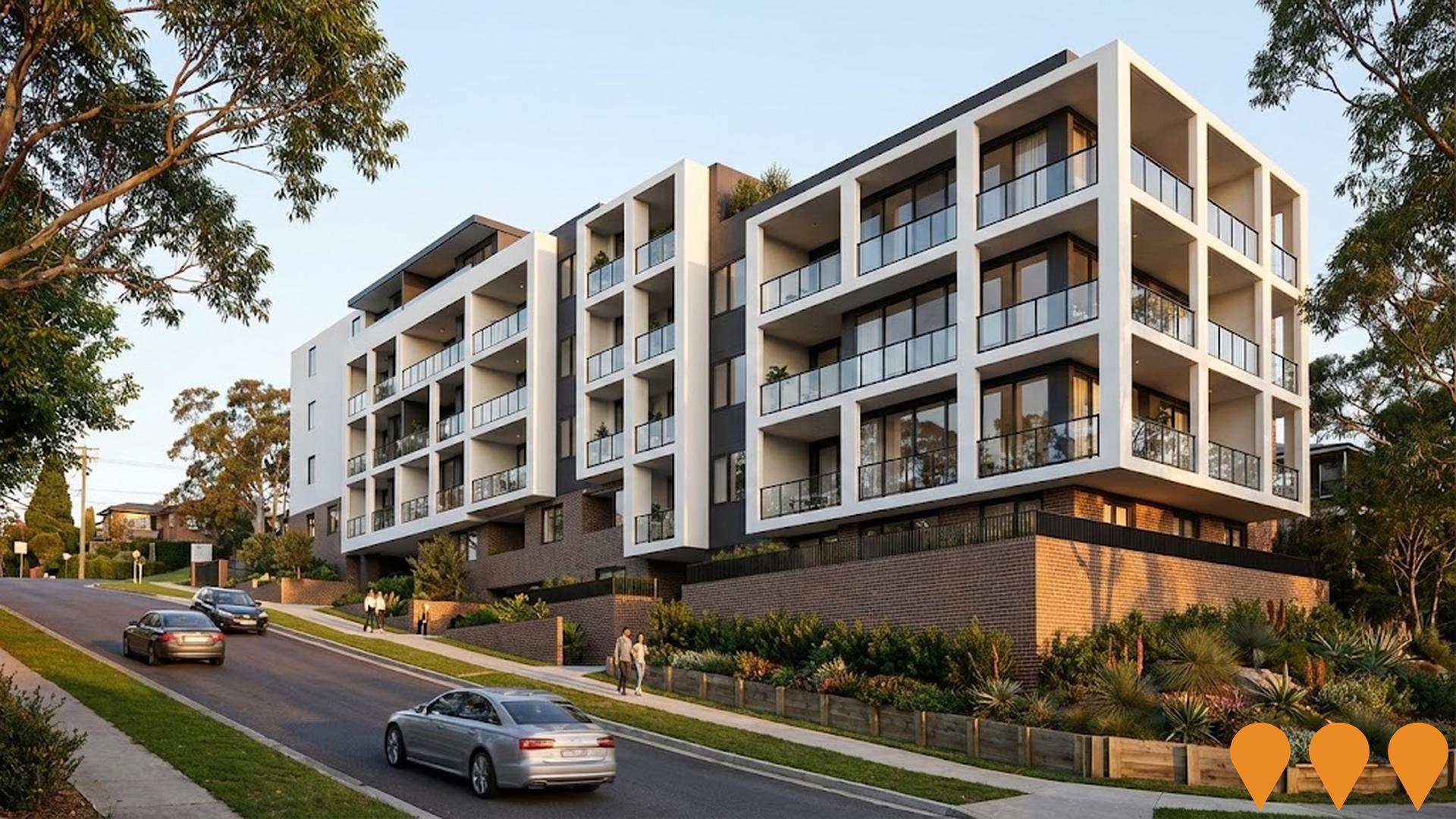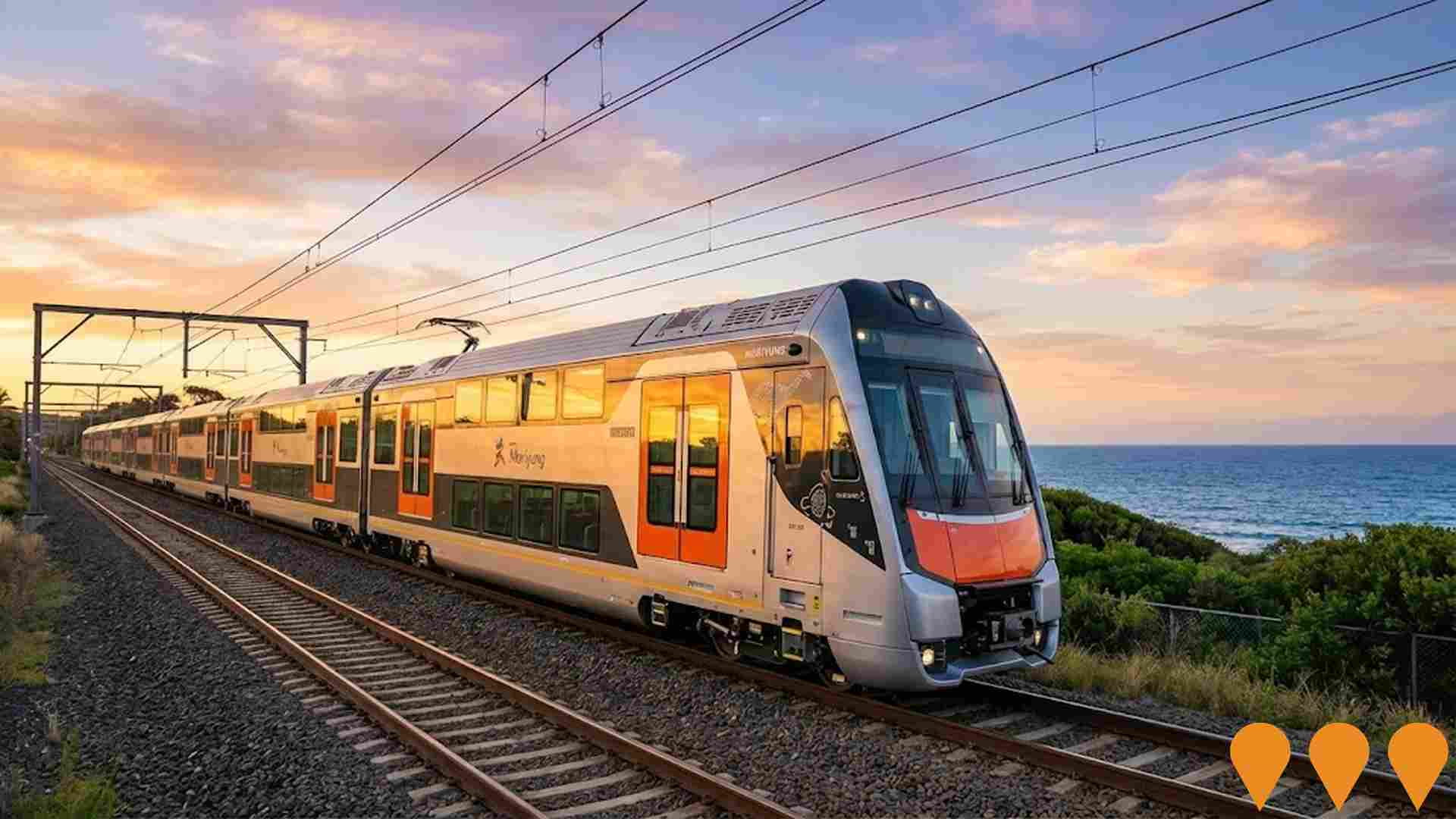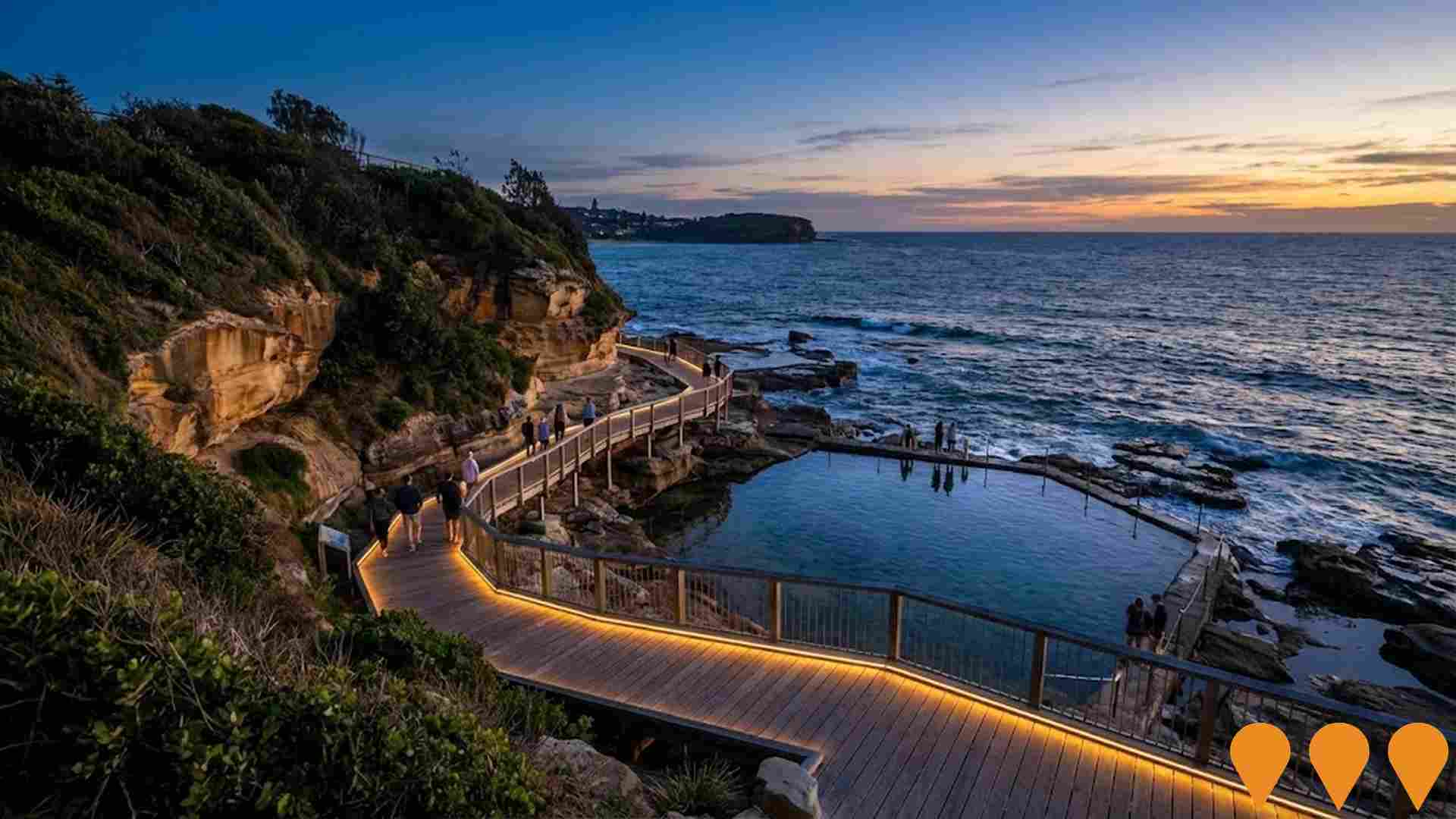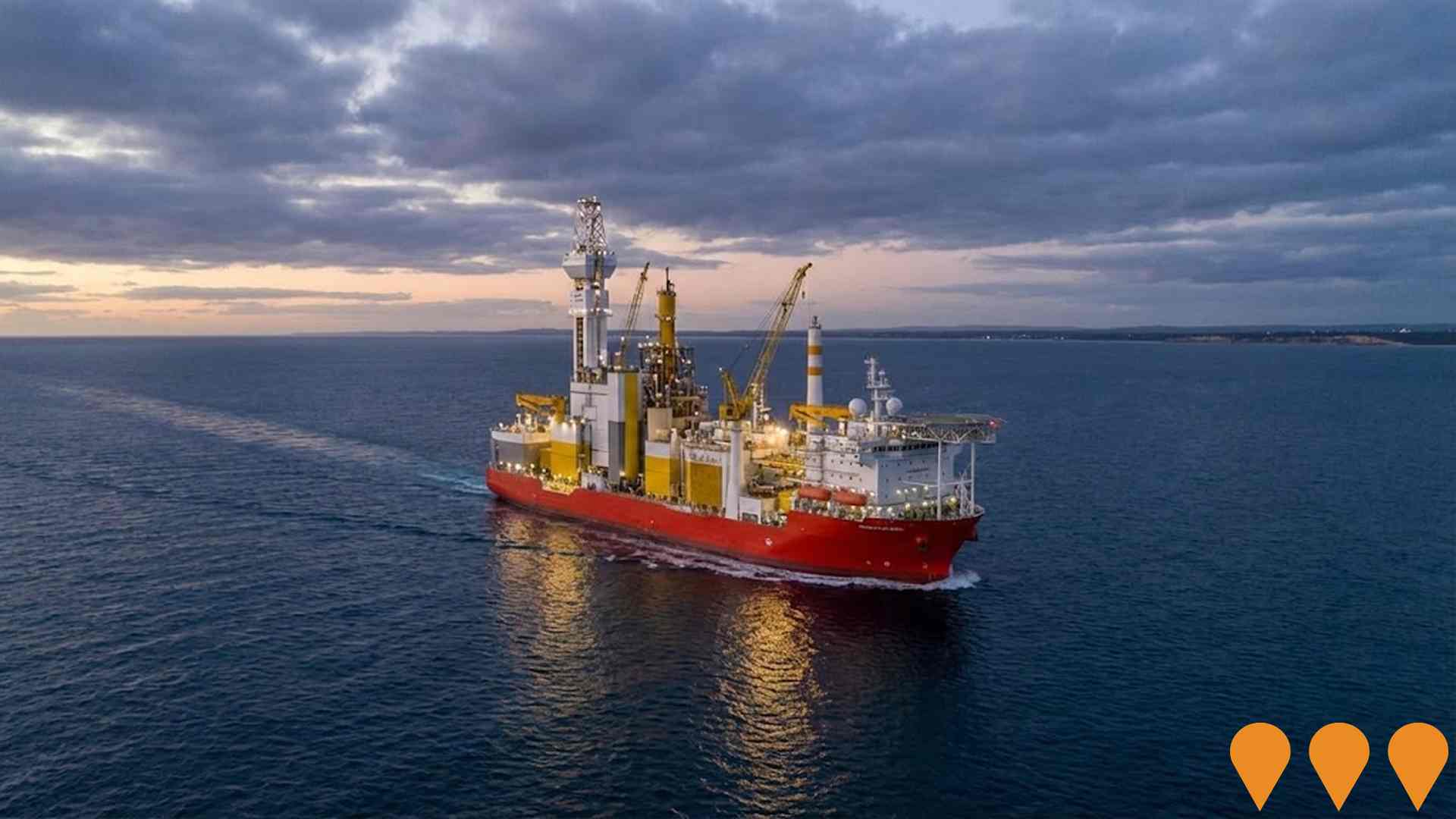Chart Color Schemes
est. as @ -- *
ABS ERP | -- people | --
2021 Census | -- people
Sales Activity
Curious about local property values? Filter the chart to assess the volume and appreciation (including resales) trends and regional comparisons, or scroll to the map below view this information at an individual property level.
Find a Recent Sale
Sales Detail
Population
Avoca Beach - Copacabana is positioned among the lower quartile of areas assessed nationally for population growth based on AreaSearch's assessment of recent, and medium term trends
As of Aug 2025, Avoca Beach - Copacabana's population is around 7,570. This reflects an increase of 57 people since the 2021 Census, which reported a population of 7,513. The change is inferred from the estimated resident population of 7,570 from the ABS as of June 2024 and an additional 22 validated new addresses since the Census date. This level of population equates to a density ratio of 1,175 persons per square kilometer. Avoca Beach - Copacabana's 0.8% growth since census positions it within 1.5 percentage points of the SA3 area (2.3%). Population growth for the area was primarily driven by overseas migration, contributing approximately 64.1% of overall population gains during recent periods.
AreaSearch is adopting ABS/Geoscience Australia projections for each SA2 area, released in 2024 with a base year of 2022. For areas not covered by this data, AreaSearch utilises NSW State Government's SA2 level projections, released in 2022 with a base year of 2021. Growth rates by age group from these aggregations are applied to all areas for years 2032 to 2041. Based on the latest population numbers, lower quartile growth is anticipated, with the area expected to expand by 128 persons to 2041, an increase of 1.7% in total over the 17 years.
Frequently Asked Questions - Population
Development
AreaSearch assessment of residential development drivers sees a low level of activity in Avoca Beach - Copacabana, placing the area among the bottom 25% of areas assessed nationally
Avoca Beach - Copacabana has seen approximately 29 new homes approved annually over the past five financial years ending June 30, 2021, totalling 146 homes. As of April 2026, three approvals have been recorded in this financial year. The population has fallen during this period, suggesting that new supply has likely kept pace with demand, offering good choice to buyers. The average construction value of these new properties is $1,064,000, indicating that developers are targeting the premium market segment with higher-end properties.
In the current financial year ending June 30, 2026, there have been $7.8 million in commercial approvals, demonstrating the area's primarily residential nature. Compared to Greater Sydney, Avoca Beach - Copacabana maintains similar construction rates per person, which has helped maintain market balance consistent with the broader area. However, construction activity has eased recently. The recent construction comprises 72.0% standalone homes and 28.0% medium and high-density housing, maintaining the area's traditional suburban character focused on family homes appealing to those seeking space.
This shows a considerable change from the current housing mix, which is currently 90.0% houses, reflecting reduced availability of development sites and addressing shifting lifestyle demands and affordability requirements. Avoca Beach - Copacabana indicates a mature market with around 342 people per approval. Looking ahead, Avoca Beach - Copacabana is expected to grow by 128 residents through to 2041. With current construction levels, housing supply should adequately meet demand, creating favourable conditions for buyers while potentially enabling growth that exceeds current forecasts.
Frequently Asked Questions - Development
Infrastructure
Avoca Beach - Copacabana has strong levels of nearby infrastructure activity, ranking in the top 40% nationally
No factor impacts a region's performance more than alterations to nearby infrastructure, significant projects, and planning endeavors. AreaSearch has pinpointed 0 initiatives that could affect this area. Notable projects encompass Terrigal Esplanade Private Access Stairs Development, Aria Terrigal, Terrigal Boardwalk and Rockpool Restoration, and Terrigal Public School Upgrade, with the following list outlining those most pertinent.
Professional plan users can use the search below to filter and access additional projects.
INFRASTRUCTURE SEARCH
 Denotes AI-based impression for illustrative purposes only, not to be taken as definitive under any circumstances. Please follow links and conduct other investigations from the project's source for actual imagery. Developers and project owners wishing us to use original imagery please Contact Us and we will do so.
Denotes AI-based impression for illustrative purposes only, not to be taken as definitive under any circumstances. Please follow links and conduct other investigations from the project's source for actual imagery. Developers and project owners wishing us to use original imagery please Contact Us and we will do so.
Frequently Asked Questions - Infrastructure
Sydney Metro
Australia's biggest public transport infrastructure program, delivering four new metro railway lines (City & Southwest, West, Western Sydney Airport, and extensions). As of December 2025, the City & Southwest line (M1) is fully operational from Chatswood to Sy1 Sydenham-Bankstown conversion is under construction with target opening 2026-2027. Sydney Metro West tunnelling is over 70% complete with all TBMs now at or past Parramatta, targeted for 2032 opening. Western Sydney Airport line civil works and station construction are progressing with services planned for airport opening in late 2026.

Low and Mid-Rise Housing Policy
State-wide NSW planning reforms via amendments to the State Environmental Planning Policy to enable more diverse low and mid-rise housing (dual occupancies, terraces, townhouses, manor houses and residential flat buildings up to 6 storeys) in well-located areas within 800 m of selected train, metro and light-rail stations and town centres. Stage 1 (dual occupancies in R2 zones statewide) commenced 1 July 2024. Stage 2 (mid-rise apartments, terraces and dual occupancies near stations) commenced 28 February 2025. Expected to facilitate up to 112,000 additional homes over the next five years.

Mariyung Fleet (New Intercity Fleet)
The Mariyung Fleet is a 610-carriage double-deck electric train fleet being delivered by RailConnect NSW (UGL, Hyundai Rotem, Mitsubishi Electric Australia) for Transport for NSW. Named after the Darug word for emu, the fleet commenced passenger services on the Central Coast & Newcastle Line on 3 December 2024, followed by the Blue Mountains Line on 13 October 2025. Services on the South Coast Line are scheduled to commence in 2026. The fleet features modern amenities including spacious 2x2 seating, charging ports, improved accessibility with wheelchair spaces and accessible toilets, CCTV emergency help points, and dedicated spaces for luggage, prams and bicycles. The trains operate in flexible 4-car, 6-car, 8-car or 10-car formations. The fleet replaces aging V-set trains that entered service in the 1970s and serves approximately 26 million passenger journeys annually across the electrified intercity network. Supporting infrastructure includes the new Kangy Angy Maintenance Facility, platform extensions, and signaling upgrades at multiple stations.

Newcastle-Sydney and Wollongong-Sydney Rail Line Upgrades
Program of upgrades to existing intercity rail corridors linking Newcastle-Central Coast-Sydney and Wollongong-Sydney to reduce travel times and improve reliability. Current scope includes timetable and service changes under the Rail Service Improvement Program, targeted network upgrades (signalling, power, station works) and the introduction of the Mariyung intercity fleet on the Central Coast & Newcastle Line, alongside Federal planning led by the High Speed Rail Authority for a dedicated Sydney-Newcastle high speed corridor.

Terrigal Boardwalk and Rockpool Restoration
The Terrigal Boardwalk is a 277-metre-long raised walking platform providing improved pedestrian access between Terrigal Beach promenade and The Haven. The project includes restoration of the adjacent rockpool with a new access ramp, pathways, and environmental protection measures. It delivers social, health, and economic benefits to the community.

Terrigal Public School Upgrade
Upgrade to provide the latest education facilities and accommodate the growing community, including a new building with 10 flexible learning spaces, upgraded administration facilities, disability car park with ramp access, and lift installation.

Crowne Plaza Terrigal Pacific Hotel Refurbishment
Major refurbishment of the iconic Crowne Plaza Terrigal Pacific including guest room renovations, restaurant and bar upgrades, conference facilities enhancement, and exterior improvements.

Aria Terrigal
Integrated mixed-use precinct delivered in stages in the heart of Terrigal, originally envisaged for around 108 residential/tourist apartments with retail and commercial space. Following the GFC the concept was split into multiple projects including Aria Building 1 (14 units) fronting Painters Lane/Campbell Crescent and the Avanti Terrigal building, plus beachfront retail along Terrigal Esplanade. Core buildings are completed and occupied.

Employment
AreaSearch analysis of employment trends sees Avoca Beach - Copacabana performing better than 90% of local markets assessed across Australia
Avoca Beach - Copacabana has a highly educated workforce with strong professional services representation. The unemployment rate was 1.2% as of June 2025.
Employment growth over the past year was estimated at 2.5%. As of June 2025, there were 4,086 residents in work, with an unemployment rate of 3.0%, below Greater Sydney's rate of 4.2%. Workforce participation was 64.4% compared to Greater Sydney's 60.0%. Key industries of employment among residents are health care & social assistance, construction, and education & training.
The area shows strong specialization in construction with an employment share of 1.5 times the regional level. Finance & insurance has limited presence at 3.7%, compared to the regional level of 7.3%. Employment opportunities appear limited locally based on Census working population vs resident population comparison. Between June 2024 and June 2025, employment levels increased by 2.5% and labour force increased by 2.7%, causing unemployment to rise by 0.2 percentage points. In Greater Sydney, employment grew by 2.6%, labour force expanded by 2.9%, and unemployment rose by 0.3 percentage points during the same period. National employment forecasts from Jobs and Skills Australia, released in May 2025, project national employment growth of 6.6% over five years and 13.7% over ten years. Applying these projections to Avoca Beach - Copacabana's employment mix suggests local growth of approximately 7.1% over five years and 14.5% over ten years.
Frequently Asked Questions - Employment
Income
Income metrics indicate excellent economic conditions, with the area achieving higher performance than 75% of national locations assessed by AreaSearch
AreaSearch's latest postcode level ATO data for financial year 2022 shows Avoca Beach - Copacabana had a median income among taxpayers of $57,293 and an average of $84,780. These figures are high compared to national averages and Greater Sydney's median of $56,994 and average of $80,856. Based on Wage Price Index growth of 12.61% since financial year 2022, estimated incomes as of September 2025 would be approximately $64,518 (median) and $95,471 (average). Census data indicates household, family, and personal incomes in Avoca Beach - Copacabana rank highly nationally, between the 69th and 82nd percentiles. Income brackets show that 30.4% of residents (2,301 individuals) earn within the $1,500-$2,999 range, similar to metropolitan regions where 30.9% fall into this bracket. The suburb demonstrates affluence with 37.4% earning over $3,000 per week, supporting premium retail and service offerings. Housing accounts for 15.1% of income, while strong earnings place residents in the 82nd percentile for disposable income. The area's SEIFA income ranking places it in the 8th decile.
Frequently Asked Questions - Income
Housing
Avoca Beach - Copacabana is characterized by a predominantly suburban housing profile, with above-average rates of outright home ownership
Dwelling structure in Avoca Beach - Copacabana, as per the latest Census, consisted of 89.8% houses and 10.2% other dwellings (semi-detached, apartments, 'other' dwellings), compared to Sydney metro's 74.2% houses and 25.9% other dwellings. Home ownership in Avoca Beach - Copacabana was at 37.4%, with the rest being mortgaged (43.4%) or rented (19.2%). The median monthly mortgage repayment was $2,438, higher than Sydney metro's average of $2,150. Median weekly rent in Avoca Beach - Copacabana was $520, compared to Sydney metro's $400. Nationally, mortgage repayments were significantly higher at $2,438 versus the Australian average of $1,863, and rents were substantially above the national figure of $375.
Frequently Asked Questions - Housing
Household Composition
Avoca Beach - Copacabana features high concentrations of family households, with a higher-than-average median household size
Family households account for 81.7 percent of all households, including 39.3 percent couples with children, 29.6 percent couples without children, and 12.1 percent single parent families. Non-family households constitute the remaining 18.3 percent, with lone person households at 16.5 percent and group households comprising 1.8 percent of the total. The median household size is 2.8 people, larger than the Greater Sydney average of 2.5.
Frequently Asked Questions - Households
Local Schools & Education
Avoca Beach - Copacabana shows strong educational performance, ranking in the upper quartile nationally when assessed across multiple qualification and achievement indicators
Educational attainment in Avoca Beach - Copacabana is notably high, with 33.8% of residents aged 15 and above holding university qualifications. This figure exceeds the SA4 region's 20.8% and the SA3 area's 25.7%. Bachelor degrees are most common at 23.6%, followed by postgraduate qualifications (6.8%) and graduate diplomas (3.4%). Vocational credentials are also prevalent, with 36.5% of residents aged 15 and above holding such qualifications - advanced diplomas account for 13.7% and certificates for 22.8%.
Educational participation is high, with 32.2% of residents currently enrolled in formal education. This includes 10.7% in primary, 9.5% in secondary, and 4.9% in tertiary education. Avoca Beach Public School and Copacabana Public School serve the area, collectively educating 717 students as of a recent report. The area's socio-educational conditions are above average, with an ICSEA score of 1076. Both schools focus on primary education, with secondary options available in nearby areas. As of the latest data, school places per 100 residents stood at 9.5, lower than the regional average of 15.9, indicating some students may attend schools outside the area.
Frequently Asked Questions - Education
Schools Detail
Nearby Services & Amenities
Transport
Transport servicing is low compared to other areas nationally based on assessment of service frequency, route connectivity and accessibility
Avoca Beach - Copacabana has 65 active public transport stops, all of which are bus stops. These stops are served by 29 different routes that together provide 355 weekly passenger trips. The area's transport accessibility is rated as excellent, with residents typically located 175 meters from the nearest stop.
On average, there are 50 trips per day across all routes, which equates to approximately 5 weekly trips per individual stop.
Frequently Asked Questions - Transport
Transport Stops Detail
Health
Avoca Beach - Copacabana's residents are extremely healthy with very low prevalence of common health conditions across all age groups
Analysis shows Avoca Beach - Copacabana has strong health metrics, with very low prevalence of common conditions across all ages. Private health cover rate is high at approximately 62%, compared to Greater Sydney's 54.7% and the national average of 55.3%. Arthritis and asthma are most common, affecting 6.9% and 6.8% respectively.
73.5% report no medical ailments, higher than Greater Sydney's 64.8%. The area has 19.8% residents aged 65+, lower than Greater Sydney's 24.5%. Senior health outcomes align with the general population's profile.
Frequently Asked Questions - Health
Cultural Diversity
Avoca Beach - Copacabana ranks below the Australian average when compared to other local markets across a number of language and cultural background related metrics
Avoca Beach-Copacabana, surveyed in 2016, had low cultural diversity with 80.5% of its population born in Australia and 94.9% speaking English only at home. The majority, 91.7%, were Australian citizens. Christianity dominated the religious landscape, comprising 48.3%.
Judaism was overrepresented at 0.5%, compared to Greater Sydney's 0.2%. Top ancestral groups were English (32.4%), Australian (26.8%), and Irish (10.6%). Notable divergences included Welsh (0.9% vs regional 0.7%), French (0.8% vs 0.5%), and South African (0.6% vs 0.5%).
Frequently Asked Questions - Diversity
Age
Avoca Beach - Copacabana hosts an older demographic, ranking in the top quartile nationwide
The median age in Avoca Beach - Copacabana is 43 years, which is higher than Greater Sydney's average of 37 years and exceeds the national average of 38 years. The age profile shows that those aged 55-64 are particularly prominent at 15.2%, while those aged 25-34 are comparatively smaller at 4.7%. Between 2021 and present, the population aged 15-24 has grown from 12.5% to 14.5%, and the 75-84 cohort has increased from 5.1% to 6.3%. Conversely, the 25-34 age group has declined from 6.8% to 4.7%. By 2041, demographic projections show significant shifts in Avoca Beach - Copacabana's age structure. The 85+ age cohort is projected to grow exceptionally, increasing by 253 people (175%) from 144 to 398. Notably, the combined 65+ age groups will account for 96% of total population growth, reflecting the area's aging demographic profile. Meanwhile, the 25-34 and 55-64 cohorts are expected to experience population declines.




